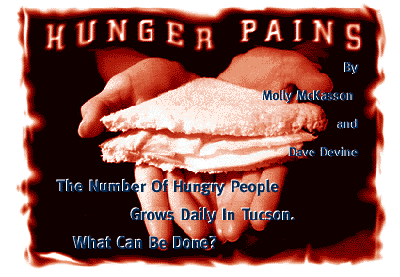
The Number Of Hungry People Grows Daily In Tucson. What Can Be Done?
By Molly McKasson and Dave Devine
INTO A MAN-MADE depression on Ajo Way, Pima County has
poured $35 million to build a new professional baseball stadium.
The massive structure includes luxury boxes and a giant scoreboard.
By March thousands of tourists will enjoy the sunshine as they
watch spring-training games at the new park.
About a mile north is the Community Food Bank's gigantic warehouse.
A large sign over the reception desk reads, "Let's not plan
how to better feed the hungry, let's plan to make feeding the
hungry part of our history." Mark Homan, author of that quote
and an honorary member of the Food Bank's board of directors,
says Tucson is a very caring community but it's not yet ready
to address the issue of curing hunger.
At schools across town, thousands of children arrive an hour
before the first bell each morning in order to eat a government-funded
breakfast. Daily, hundreds of senior citizens are fed hot lunches
at neighborhood centers, or through one of several home-delivered
meals programs. Every day, tens of thousands of people in Tucson
are receiving help just to have something to eat.
 Despite these efforts, many people remain hungry. But it's difficult
to tell who they are because, as Ilya Sloan of the Community Food
Bank says, "Hunger doesn't show in people."
Despite these efforts, many people remain hungry. But it's difficult
to tell who they are because, as Ilya Sloan of the Community Food
Bank says, "Hunger doesn't show in people."
Exact figures about how many people in Tucson are routinely hungry
are not available. Applying national figures locally, however,
allows for a conservative estimate that daily hunger afflicts
about 20,000. That's continual, achingly empty stomach hunger,
not just missing a meal once in awhile. The number is almost twice
as many as will fill the new ballpark on opening day.
THE HUNGRY COME from all parts of the city, from every
age group and race. Ninety-nine percent of them are not the homeless.
They're average citizens. Many of them even have full-time jobs.
They all have one thing in common: They lack the money to properly
nourish themselves. Sadly enough, the majority of them are children
and seniors.
At one end of the age range, Tucson's elderly in large numbers
face hunger daily. They're the hidden hungry who don't complain,
don't demand, and often don't go out of their homes.
The primary group of senior citizens facing hunger, according
to Diana Edwards of the Pima Council on Aging, "is among
older women behind closed doors who are too proud to ask for help.
There are more than I want to think about. Far beyond the 11 percent
of the population of seniors who live below the poverty level."
Numerous programs provide some food for older people. These include
inexpensive hot lunches served to hundreds of participants at
neighborhood and other centers around town. Over 3,000 senior
households receive a supplemental brown bag of items from the
Community Food Bank each month, and many others participate in
the Food Plus program there.
Food stamps are available for eligible older people, and more
than 1,000 homebound seniors are delivered meals each weekday.
These efforts are helpful, but it's generally agreed among those
who operate the programs that they aren't adequate to meet the
food needs of Tucson's lower-income senior citizens.
Judi Arnett, an eligibility worker and route driver for Catholic
Social Service's Pima Meals on Wheels program, sees dozens of
elderly Tucsonans when she delivers food to them twice a week.
"There are so many pitiful people out there," she says.
"Most of the clients wait for us to arrive. We're the only
socialization that some of them have, their one little joy of
the day. Sometimes their family doesn't take care of them. Others
just have nobody else."
At the first stop on her route, a man approaching 80 who lives
in a small, neatly kept adobe house donates $1 to help defray
the cost of his meal. Later, Judi gives a woman who has just celebrated
her 90th birthday a small crocheted basket with crackers in it.
She smiles a wide toothless grin upon receiving the gift.
The availability of food stamps is of little help to many of
these people. Because they lack transportation, have medical problems,
believe there's always someone else who needs the help more, or
have too much pride, most eligible seniors don't use food stamps.
Nationwide, only 35 percent of those who could receive them actually
do.
Instead, many Tucson seniors rely on the one meal a day provided
to them by an agency. They survive the rest of the time by eating
what Marian Lupu of the Pima Council on Aging refers to as a "tea
and toast" diet.
The agency meal contains one-third of the necessary basic daily
nutrition. Since most agency meals are available only on weekdays,
many seniors subsist on soup and the kindness of family and church
through the weekend. Or people just go hungry until the next delivered
meal arrives.
Despite that, those who are fed through these programs are the
lucky ones. Many eligible senior citizens in Tucson either aren't
participating or are stuck on waiting lists. As the community
continues to grow, these problems are expected to increase.
Fortunately, the hunger situation for seniors seems to be less
serious than among the general population. During the 1970s, Americans
were horrified to learn that a huge percentage of our senior citizens
were living in poverty without proper healthcare or nutrition.
Numerous groups united to change that shameful situation and have
at least partially succeeded.
UNFORTUNATELY, IN THE same two decades since the 1970s,
poverty among children in our country has grown at an alarming
rate. Pima County has kept pace, and now even slightly exceeds
the national average of 23 percent. Bold public policy helped
reduce hunger among our elders. How can we not do the same for
the very young?
Locally, hungry children move invisibly all around us. At 7:30
a.m. on a typical Wednesday, in the cafeteria of a midtown elementary
school, kids have been lining up for 20 minutes. They're bumping
and joking with each other. Many of them got here on foot. There's
no busing to this school.
Some of the boys wolf down a little cereal and rush outside to
play. But most of the kids look hungry, and finish everything
they're given before leaving.
At this school there were 154 meals served under the federally
sponsored School Breakfast Program. Thirteen of those were at
a reduced cost and 141 were provided free.
By 8 a.m. the cafeteria is closing down so food services personnel
can start preparing lunch. They expect to dish out around 500
noontime meals to the school's 590 students. Of those, 390 will
be free lunches, 40 provided at a reduced rate, and the remaining
70 students will pay $1.25 apiece.
 What's not typical about this scene is that it takes place in
a once-stable middle-class Tucson neighborhood. Modest but attractive
brick homes are prevalent, and you'd never describe it as a poor
or blighted area. But over the past 15 years, with stagnant low
wages and declines in manufacturing jobs in the community, an
overwhelming majority of the children from this working-class
neighborhood now meet the federal guidelines for free or reduced-cost
breakfast and lunch.
What's not typical about this scene is that it takes place in
a once-stable middle-class Tucson neighborhood. Modest but attractive
brick homes are prevalent, and you'd never describe it as a poor
or blighted area. But over the past 15 years, with stagnant low
wages and declines in manufacturing jobs in the community, an
overwhelming majority of the children from this working-class
neighborhood now meet the federal guidelines for free or reduced-cost
breakfast and lunch.
At this one school, 76 percent of the students come from homes
where the income falls below 130 percent of the federal poverty
level, therefore qualifying them for the subsidized lunch program.
In typical "poor areas" of town, elementary schools
are serving between 90 and 99 percent free lunches.
No matter where you lean on the political spectrum, all of us
should be grateful there's such a thing as a free lunch. More
than a few principals, teachers and employees are convinced that
without these food programs, many of the 55,000 children certified
for subsidized meals in the largest school districts in our community
would go undernourished every day.
These kids have some things in common with Tucson's hungry senior
citizens. The head of food services for one school district says
there are a lot more families who could qualify for the free meals,
and really need the help, but who are too proud to ask. A principal
at a central city school fears the free lunch may be the only
meal many of her students eat the entire day.
Those who study poverty and hunger agree that Tucson has a very
serious problem when it comes to children going hungry. It's an
issue which can't be divorced from the inability of working parents
to meet the basic needs of their families.
At the Community Food Bank, they distribute enough food for 24,000
meals a day. Sixty percent of that food goes to children. One
in four kids in Pima County lives in poverty. The fastest-growing
sector of poverty in our community is among families with children
under five.
Those who work closely with people in need are quick to say that
hunger is the huge but silent toll of poverty in our midst. Parents
must accept that their children are a little bit hungry because
there are other, more inflexible and very visible priorities.
If the rent doesn't get paid, the children could be homeless.
If the car payment isn't made or needed repairs neglected, the
parents might be unable to get to their jobs.
Instead, parents are left to cut calories and nutrition. First
they'll do it for themselves, then if necessary for the kids.
A child doesn't show irreparable damage because of it. In fact,
some undernourished children look plumper than their healthy counterparts.
So why does it matter that a large percentage of our community's
children are growing up hungry? According to the research done
over the past two decades, it matters a lot to the health of individuals
and communities.
In 1995, the Center on Hunger, Poverty and Nutrition Policy at
Tufts University outside Boston released a report entitled "The
Link Between Nutrition and Cognitive Development in Children."
In the information age, where the mind, and not the back, determines
the haves from the have-nots, this well-researched document is
a much-needed wake-up call.
Dr. Ernesto Pollit, professor of pediatrics at the University
of California at Davis, wrote in the report, "We have now
learned that even moderate undernutrition, the type seen most
frequently in the U.S., can have lasting effects on the cognitive
development of children. Inadequate nutrition is a major cause
of impaired cognitive development, and is associated with increased
educational failure among impoverished children."
The report also said, "This evidence suggests that undernutrition
costs far more than the diminished well-being of youngsters during
childhood. By robbing children of their natural human potential,
undernutrition results in lost knowledge, brainpower and productivity
for our nation."
The Tufts report concluded, "Unfortunately, the effects
that poor health have on learning and educability are often not
incorporated into efforts to improve our education system. Key
educational problems such as drop-outs or school failure are rarely
examined in terms of the health and nutritional status of poor
children."
WHETHER WE AS a society should be investing more in children,
their families and their grandparents is now a major public policy
battle at every level of government. Despite Tucson's caring social
services, wellness centers and volunteers, the gap between needs
and resources grows ever wider for our oldest and youngest. It's
a wound which charity alone cannot close.
Current financial realities for social service agencies mean
that some people either have to wait to get food or the amount
they receive is less. Mobile Meals of Tucson volunteers deliver
special diet meals to 225 clients, but another 80 people linger
on the organization's waiting list. Because of budgetary shortfalls,
the number of food items in the senior brown bags distributed
by the Food Bank had to be reduced a few months ago.
Federal and state welfare reform over the past two years has
had a direct impact on the hungry. More than 600 seniors and 1,500
other households in Pima County have recently lost all access
to food stamps because Congress decided legal immigrants no longer
needed the assistance. It will be several years before we know
how seriously this change has impaired the health of individuals
and the success of young ones in these families.
The amount of money being saved by these budget reductions is
small compared to the price of the new baseball stadium. But it's
a large jolt to the affected agency. These cost-cutting measures
reflect the reality of consistently static funding in the face
of an ever-growing demand for food services in Tucson.
The Food Bank is saving $8,000 to $10,000 a month by its brown
bag reductions. Mobile Meals of Tucson would have to increase
both its budget and the number of volunteer drivers to eliminate
its waiting list. Pima Meals on Wheels saves about $100,000 a
year by not delivering hot meals five times a week, but instead
providing two hot meals and three frozen ones twice a week.
The dedicated volunteers and professional staffs who manage and
operate the programs for Tucson's hungry provide a great service.
But they generally seem resigned to a worsening situation which
won't be adequately addressed. Marian Lupu, of Pima Council on
Aging, says, "Until our priorities change from building prisons
to providing social services, from politicians who see more advantage
in getting elected by supporting social benefits and not tax rebates,
things won't change."
Punch Woods at the Food Bank is glowing in his praise of the
community's support for the daily needs of the hungry. But, he
believes, "This response to hunger is in some ways a hindrance
to finding a solution. The real needs of people are to have access
to food through incomes or the food stamp program which will allow
that. It's tragic that we need to support charities to feed people."
Ilya Sloan, also of the Food Bank staff, says, "We need
education and advocacy in the community to look for solutions
to this problem. We're not addressing the root cause of the hunger
issue now." Linda Osterkamp, at Mobile Meals of Tucson, adds,
"It's discouraging when the City Council gives money to things
like the Copper Bowl when people are hungry in Tucson."
TO SOLVE TUCSON'S growing hunger problem, many of those
involved with the issue are stressing the need to come up with
actual cures as well as continuing to feed the hungry. Christine
Vladimiroff, president of the national organization Second Harvest,
believes four steps are necessary to change the situation:
The first step, she writes, is to protect social safety net programs
like W.I.C. and food stamps. Next, a reduction in the rate of
poverty must be addressed. Third, support for charitable organizations
must be continued. Finally, education of the public about the
problem of hunger in America is required.
It's very possible the public might have to take the lead in
reducing poverty. There are six questions which we need to ask
of our elected officials in the next year:
What's local government doing to reduce poverty, especially
as it affects families with very young children?
 What wage is really required to provide for the basic
needs of a family of four in Tucson?
What wage is really required to provide for the basic
needs of a family of four in Tucson?
Of the local jobs created in the last two years, how
many paid above the minimum wage? (Estimates show that only one-half
of them did.)
With so many children at risk in Arizona, why has the
state Legislature only adopted a resolution supporting the 1995
Children's Nutritional Bill of Rights--without taking steps to
implement it?
How can state politicians propose to give millions
of dollars back to wealthy taxpayers when so many of our people
are undereducated, untrained, and unable to make a livable wage?
Which of our state legislators will vote in 1998 to
spend a pittance of $500,000 to fund a Community Food Development
Grant to help create initiatives to fight hunger throughout Arizona?
As poverty increases in Tucson, the ranks of the hungry will
grow. The community's generosity and commitment to helping them
can't keep pace. Without the political will to confront the poverty
issue, the poor and hungry will always be with us--but now, it
appears, they'll be with us in ever-larger numbers.

|





